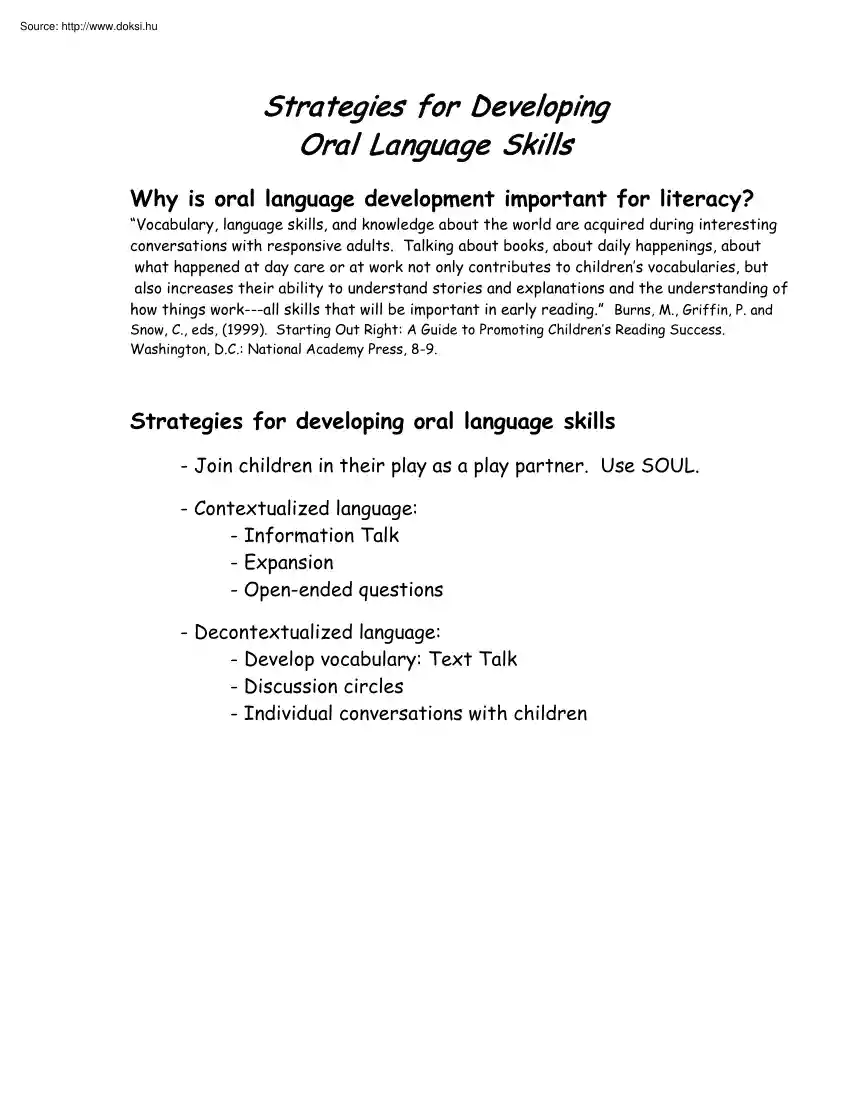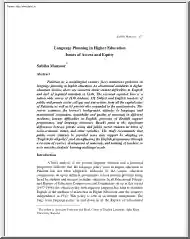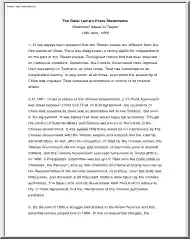Értékelések
Nincs még értékelés. Legyél Te az első!
Tartalmi kivonat
Strategies for Developing Oral Language Skills Why is oral language development important for literacy? “Vocabulary, language skills, and knowledge about the world are acquired during interesting conversations with responsive adults. Talking about books, about daily happenings, about what happened at day care or at work not only contributes to children’s vocabularies, but also increases their ability to understand stories and explanations and the understanding of how things work---all skills that will be important in early reading.” Burns, M, Griffin, P and Snow, C., eds, (1999) Starting Out Right: A Guide to Promoting Children’s Reading Success Washington, D.C: National Academy Press, 8-9 Strategies for developing oral language skills - Join children in their play as a play partner. Use SOUL - Contextualized language: - Information Talk - Expansion - Open-ended questions - Decontextualized language: - Develop vocabulary: Text Talk - Discussion circles - Individual
conversations with children Strategies for Developing Contextualized Language Open- ended Questions Questions that have more than one right answer, or ones than can be answered in many ways, are called open-ended or divergent questions. This way of asking questions stimulates more language use, acknowledges that there can be many solutions to one problem, affirms children’s ideas, and encourages creative thinking. Open-ended questions open up conversations. When you ask an open-ended question, you don’t know what the child’s answer is going to be. Close-ended questions usually limit conversation to a one or two word response and sometimes the end conversation. Examples: Close-ended question: Open-ended question: “What color is this?” “ You used a lot of blue on your painting. What does it remind you of?” Close-ended question: Open-ended question: “How many teddy bears are on the block?” “What are those teddy bears thinking about?” Close-ended question:
Open-ended question: “What’s your doll’s name?” “Your baby is so beautiful! Tell me about her.” For English Language Learners: Open-ended questions may be very difficult to understand and answer if the child is at a beginning level of language development. Close-ended questions, in contrast, provide limited vocabulary and simple choices that are easier for beginning English Language Learners to understand. As the child acquires language, the adult can gradually ask more complex close-ended questions and eventually move on to asking open-ended questions. “It helps if teachers use ‘yes/no’ questions with beginning English language learners, because these questions are easier than ‘what’ questions, and ‘what’ questions are easier than ‘where’ or ‘when’ questions. ‘How’ and ‘why’ questions are the most difficult for new speakers of the language.” McLaughlin, Barry “Fostering Second Language Development in Young Children: Principles and
Practices", National Center for Research on Cultural Diversity and Second Language Learning, 1995. wwwncelagwuedu/miscpubs/ncredsll/epr14htm “Never ask a child a question that you already know the answer to.” David Weikart, former president, High/Scope Educational Research Foundation Open- ended Questions How did you Why did you How do you know? What did you do first? What could you do instead? What is it made of? What do you think? How did you do that? What can you tell me about Can you think of another way What do you think would happen if What does it remind you of? What can you do next time? Tell me what happened. How are you going to do that? Is there anything else you could use? What do you think will happen next? Implementation Tip: Some teachers have found it effective to enlarge this page, duplicate it, and post it in their classroom as a reminder to help them ask open-ended questions. In Imagineering (New York: McGraw-Hill, 1980), Michael LeBoeuf
proposed asking questions to spark your imagination. He gave these examples that can spark creativity when faced with a challenge. • What can be added? • What if this were exaggerated? • What else can this be used for? • What is being wasted that can be put to use? • What else is this like? • What else can be adapted? • Is there something I can duplicate? • How can this be done better and more cheaply? • How can this be made more appealing? • What can be substituted? • What should be subtracted? • Can it be done faster? • What ideas can be combined? • How can this be condensed? • How else can this be arranged? • What is the opposite of this? • What if nothing is done? Strategies for Developing Contextualized Language Types of Open- ended Questions To put thoughts into words: Why do you think the little boy in the story was sad? To observe: What do you see, hear, feel? What did you notice? To make
predictions: What do you think will happen if you keep adding blocks to your tower? To think about similarities and differences: How are these two blocks the same? What makes these things go together? To apply knowledge to solve a problem: What could you do to keep the paint from dripping on the floor? To stretch thinking: What would happen if there were no cars, trucks, buses, planes, or boats? How would we get around? To consider consequences: What would happen if you left your drawing outside and it rained? To evaluate: What made you decide to pick this book to read? How did this make you feel? To assess feelings: How would you feel if that happened to you? Dodge, Diane Trister, Colker, Laura J. and Heroman, Cate (2002) The Creative Curriculum for Preschool, Washington D.C: Teaching Strategies
conversations with children Strategies for Developing Contextualized Language Open- ended Questions Questions that have more than one right answer, or ones than can be answered in many ways, are called open-ended or divergent questions. This way of asking questions stimulates more language use, acknowledges that there can be many solutions to one problem, affirms children’s ideas, and encourages creative thinking. Open-ended questions open up conversations. When you ask an open-ended question, you don’t know what the child’s answer is going to be. Close-ended questions usually limit conversation to a one or two word response and sometimes the end conversation. Examples: Close-ended question: Open-ended question: “What color is this?” “ You used a lot of blue on your painting. What does it remind you of?” Close-ended question: Open-ended question: “How many teddy bears are on the block?” “What are those teddy bears thinking about?” Close-ended question:
Open-ended question: “What’s your doll’s name?” “Your baby is so beautiful! Tell me about her.” For English Language Learners: Open-ended questions may be very difficult to understand and answer if the child is at a beginning level of language development. Close-ended questions, in contrast, provide limited vocabulary and simple choices that are easier for beginning English Language Learners to understand. As the child acquires language, the adult can gradually ask more complex close-ended questions and eventually move on to asking open-ended questions. “It helps if teachers use ‘yes/no’ questions with beginning English language learners, because these questions are easier than ‘what’ questions, and ‘what’ questions are easier than ‘where’ or ‘when’ questions. ‘How’ and ‘why’ questions are the most difficult for new speakers of the language.” McLaughlin, Barry “Fostering Second Language Development in Young Children: Principles and
Practices", National Center for Research on Cultural Diversity and Second Language Learning, 1995. wwwncelagwuedu/miscpubs/ncredsll/epr14htm “Never ask a child a question that you already know the answer to.” David Weikart, former president, High/Scope Educational Research Foundation Open- ended Questions How did you Why did you How do you know? What did you do first? What could you do instead? What is it made of? What do you think? How did you do that? What can you tell me about Can you think of another way What do you think would happen if What does it remind you of? What can you do next time? Tell me what happened. How are you going to do that? Is there anything else you could use? What do you think will happen next? Implementation Tip: Some teachers have found it effective to enlarge this page, duplicate it, and post it in their classroom as a reminder to help them ask open-ended questions. In Imagineering (New York: McGraw-Hill, 1980), Michael LeBoeuf
proposed asking questions to spark your imagination. He gave these examples that can spark creativity when faced with a challenge. • What can be added? • What if this were exaggerated? • What else can this be used for? • What is being wasted that can be put to use? • What else is this like? • What else can be adapted? • Is there something I can duplicate? • How can this be done better and more cheaply? • How can this be made more appealing? • What can be substituted? • What should be subtracted? • Can it be done faster? • What ideas can be combined? • How can this be condensed? • How else can this be arranged? • What is the opposite of this? • What if nothing is done? Strategies for Developing Contextualized Language Types of Open- ended Questions To put thoughts into words: Why do you think the little boy in the story was sad? To observe: What do you see, hear, feel? What did you notice? To make
predictions: What do you think will happen if you keep adding blocks to your tower? To think about similarities and differences: How are these two blocks the same? What makes these things go together? To apply knowledge to solve a problem: What could you do to keep the paint from dripping on the floor? To stretch thinking: What would happen if there were no cars, trucks, buses, planes, or boats? How would we get around? To consider consequences: What would happen if you left your drawing outside and it rained? To evaluate: What made you decide to pick this book to read? How did this make you feel? To assess feelings: How would you feel if that happened to you? Dodge, Diane Trister, Colker, Laura J. and Heroman, Cate (2002) The Creative Curriculum for Preschool, Washington D.C: Teaching Strategies





